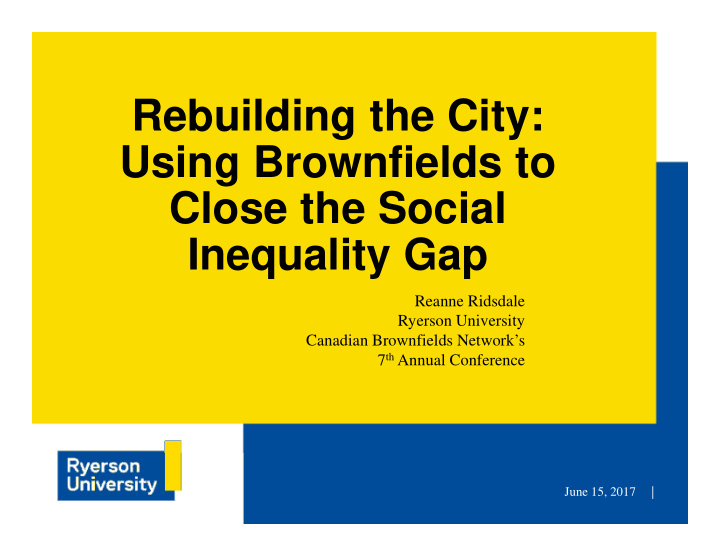



Rebuilding the City: Using Brownfields to Close the Social Inequality Gap Reanne Ridsdale Ryerson University Canadian Brownfields Network’s 7 th Annual Conference June 15, 2017 |
Background to Sustainability: Sustainability is to alleviate poverty, enhance social equality, and justice (WCED, 1987). Status quo development will “compromis[e] the ability of future generations”, but she also critiqued societies’ “inability to promote the common interest in sustainable development is often a product of the relative neglect of economic and social justice within and amongst nations” (WECD, 1987, p. 40). June 15, 2017 | 2
June 15, 2017 | 3
Sustainability Principles are Needed Ridsdale & Noble, 2016; Ridsdale, 2015 (unpublished thesis) 1. Relationships Between the Pillars Acknowledged 2. Intragenerational Equity 3. Intergenerational Equity 4. Participatory by Design 5. Culturally Appropriate Participation 6. Minimize Trade-offs But, certain principles and elements are missing… June 15, 2017 | 4
SuRF Technical Initiative June 15, 2017 | 5
SuRF Technical Initiative, Part Two • 26 members • Global outreach � Roadmap for SR Community � Outline social methodology & stakeholder processes June 15, 2017 | 6 Arnstein, 1969
My Research: Social Justice in SR & Brownfields Distributive Justice • Net benefit & impacts spatially distributed Procedural Justice • Concerned with the ‘how’ of social justice (Boström et al., 2015) Substantive Justice • ‘Tangible’ outcomes, decisions, or benefits of social justice (Bronstöm et al., 2015; Sadurski, 1985). June 15, 2017 | 7
Hulchanski, 2010
Potential Criteria: Contamination Free Transit Employment Access Education Access (K-12/13, post-secondary, trades) Access to Food Greenspace Access Urban/Community Gardens Housing Childcare Access to Recreation Centers Access to Religious Centers Access to Cultural & Art Centers Health Care Access
Do we have the right tools? Are we asking the right questions? June 15, 2017 |
Thank you! Reanne Ridsdale Dridsdale@ryerson.ca June-16-17
References: Arnstein, S. (1969). A ladder of citizen participation. Journal of American Planning Association, 216- 224. Boström, M., Å. Casula Vifell, M. Klintman, L. Soneryd, K. Hallström, & R. Thedvall. (2015) Social sustainability requires social sustainability: Procedural prerequisites for reaching substantive goals. Nature and Culture, 10 , 2, 131-156. Harclerode, M., R. Ridsdale, D. Darmendrail, P. Bardos, F. Alexandrescu, P. Nathanail, L. Pizzol, & E. Rizzo. (2015). Integrating the social dimension in remediation decision-making: state of the Practice and way forward. Journal of Remediation, p. 11- 42. Hulchanski, D. (2010). The Three Cities Within Toronto: Income Polarization Among Toronto’s Neighbourhoods, 1970-2005. Cities Centre Press, University of Toronto. Ridsdale, R. & B. Noble. (2016). Assessing sustainable remediation frameworks using sustainability principles. Journal of Environmental Management, 184 , p. 36-44. Ridsdale, R. (2015). Assessing sustainable remediation frameworks using sustainability discourse. (Unpublished master’s thesis). University of Saskatchewan, Saskatoon, Saskatchewan, Canada. Sadurski, W. (1985). Giving Desert Its Due: Social Justice and Legal Theory. Dordrecht; Springer Science + Business Media. World Commission on Environment and Development. (1987). Our common future: report of the world commission on environment and development . Annex document A/42/427
Recommend
More recommend